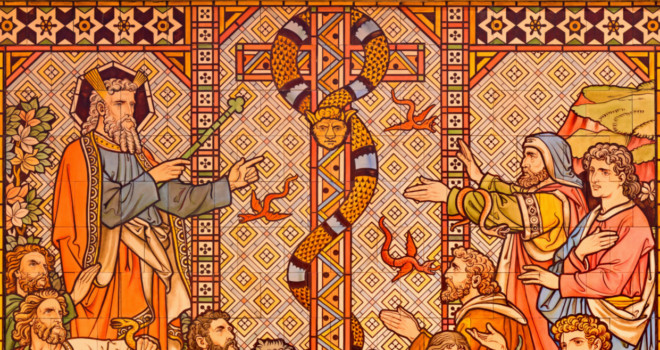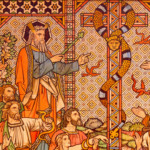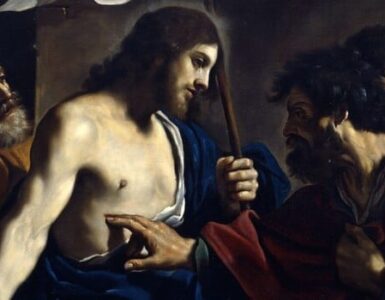Of all the Old Testament foreshadowings of the cross, the most confusing might be the bronze serpent that Moses lifted up to heal Israelites bitten by snakes in Numbers 21.
Moreover, this is a parallel that Jesus Himself
endorses in John 3:14,
And just as Moses lifted up the serpent in the desert, so must the Son of Man be lifted up.
The shape of the serpent on the cross is said to
have resembled that of the cross. The idea of gazing upon an image of the cross
and receiving healing is richly evocative. But the serpent doesn’t seem to fit.
We tend to immediately associate the serpent here
with the tempter of Eden. So it seems strange to think of that as a type—a
person, place, thing, or event that foreshadows Christ in some way. St. Gregory
Nazianzus’ solution is to see this as an anti-type—the opposite of Christ that points
to His work by way of contrast. This is a potentially valid way of looking at
things, but it’s tough to accept here because Christ Himself seems to be making
a positive analogy. “Just as” implies some similarity.
In order to look at the other interpretation, it’s
helpful to realize that the serpent need not be identified with the one in
Eden. As this commentator points out,
in Eden, the devil acted contrary to God’s will. The serpents in Numbers 21,
however, were sent to execute His punishment on the ungrateful Israelites.
There is a way of positively identifying the bronze
serpent with Christ.
One Catholic commentator puts it
this way: “There is no clear teaching on this; however we can consider that the
serpent is a symbol of death, and in order for Christ to save us he must become
“death” on the cross.” In each case, the cause of our demise was redeemed and
transformed into a source of salvation. On the cross, we were saved by means of
the very nature that doomed us in the first place. And death, once something to
be feared, became the gateway to grace.
This idea of redemption might be supported by the
textual history of the word serpent in the Old Testament. In the Hebrew, the
word for serpent in Numbers 21 is saraph.
That word should sound familiar. It’s also the same word used to describe the
particular angels that guard God’s throne in Isaiah
6—the seraphim.
There is not as much distance between the two as we
might think: both judgment and mercy, like the saraphs and seraphim, are sent
forth from God. Ultimately, the cross was a moment of both judgment and
mercy—redemption for those who accepted its offer, and judgment upon those who
do not.
On a more mystical level, in both Numbers 21 and at
the crucifixion, the reality lies beyond what you see, as this Jewish
commentator says
in speaking of the Old Testament. While it may have been the snake that they
saw, it was really the power of God behind it that saved the ancient
Israelites, according to the commentator. This is exactly what Wisdom 16:5-7
says,
For when the dire venom of beasts came upon them
and they were dying from the bite of crooked serpents,
your anger endured not to the end.
But as a warning, for a short time they were terrorized,
though they had a sign of salvation, to remind them of the precept of your law.
For the one who turned toward it was saved,
not by what was seen,
but by you, the savior of all.
So also on the cross, what was visible was the infirmity of a man crucified. But, in truth, it was the power of God. Just as it takes eyes of faith to look at a bronze serpent and hope for healing, so also one must look beyond the visible crucifixion to see the reality of redemption.
✠













